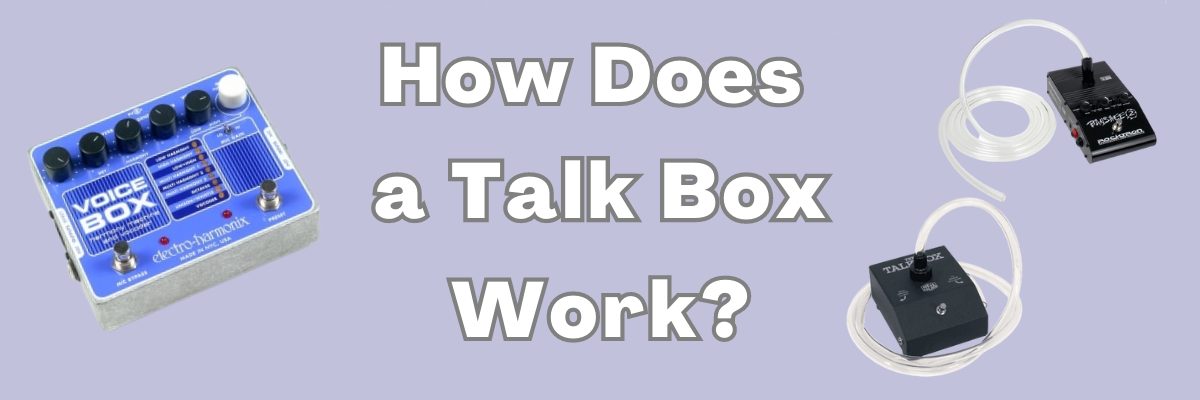So how does a Talk Box work? The talk box is one of the most iconic and mysterious vocal effects in the history of modern music.
Table of Contents
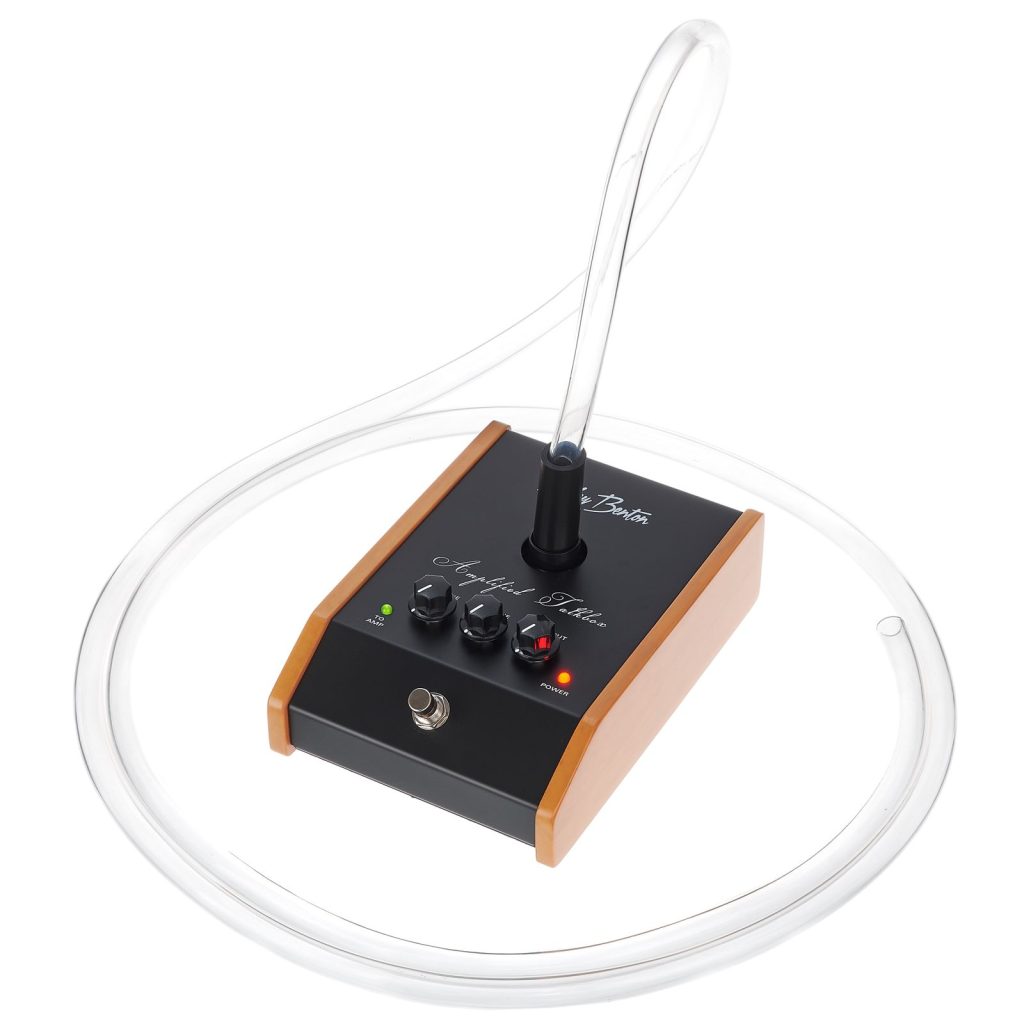
Hi. Ian here, and welcome to this article!
If you’re a musician, you’ve probably heard of a talk box before. It’s that effect that makes guitars sound like they’re talking. But how does it actually work?
In this article, we’re going to take a deep dive into the world of talk boxes and learn everything there is to know about them. We’ll cover everything from the history of the talk box to the science behind how it works. We’ll also give you some tips on how to use a talk box to create your own unique sounds.
What is a talk box?
A talk box is an effects unit that allows musicians to modify the sound of a musical instrument by shaping the frequency content of the sound. It works by directing the sound from the instrument into the musician’s mouth using a plastic tube. The musician controls the modification of the instrument’s sound by changing the shape of the mouth.
How does a talk box work?
The talk box works by using the human mouth as a filter. When you speak, you change the shape of your mouth to produce different sounds. The talk box works similarly, but instead of using your mouth to produce different sounds, you’re using it to modify the sound of a musical instrument.
The sound from the instrument travels through the plastic tube into your mouth. As you change the shape of your mouth, you change the way that the sound is filtered. This allows you to create a variety of different effects, from simple “wah-wah” sounds to complex words and phrases.
History of the talk box
The talk box was invented in the 1930s by Alvino Rey, a guitarist who was known for his innovative playing techniques. Rey used the talk box to create a variety of different effects, including the famous “talking guitar” sound that was later used by other musicians such as Peter Frampton and Roger Troutman.
How to use a talk box
To use a talk box, you’ll need to connect it to your instrument and your amplifier. You’ll also need to place the plastic tube in your mouth. Once you’re set-up, you can start playing your instrument and using your mouth to shape the sound.
Here are a few tips for using a talk box:
- Use a clean sound. The talk box will work best with a clean, undistorted sound.
- Experiment with different mouth shapes. The different shapes that you make with your mouth will produce different effects.
- Use a microphone. To amplify the sound of your talk box, you’ll need to use a microphone.
The talk box is a unique and versatile effects unit that can be used to create a variety of different sounds. If you’re a musician, I encourage you to experiment with a talk box to see what kind of sounds you can create.
Resources
- Wikipedia: Talk box: https://en.wikipedia.org/wiki/Talk_box
- HowStuffWorks: How Talk Boxes Work: https://electronics.howstuffworks.com/gadgets/audio-music/talk-box.htm
- Sweetwater: What is “Talk Box”?: https://www.sweetwater.com/insync/talk-box/
Talk boxes can be used by musicians of all genres, from rock to pop to hip-hop. They’re a great way to add a unique and interesting sound to your music.
If you’re interested in learning more about talk boxes, I recommend checking out the following resources:
- The Talkbox FAQ: This website provides a comprehensive overview of talk boxes, including how they work, how to use them, and a list of popular talk box players.
- The Talkbox History: This website provides a brief history of talk boxes, from their invention in the early 1900s to their use by popular musicians today.
- The Talkbox Tutorial: This video tutorial provides a step-by-step guide on how to use a talk box.
Talk Boxes vs Vocoders – Understanding the Key Differences
The talk box and the vocoder are two classic audio effects that have been used by musicians for decades to alter vocals and create robotic or synthetic vocal sounds. But what exactly are these effects and how do they differ? This guide will explain the key differences between talk boxes and vocoders and how each effect works.
Talk Box Overview:
A talk box is a mechanical audio effect that reroutes a musician’s vocal sounds through an external speaker. The speaker is usually built into a small enclosure that has a tube leading from it. The performer places the tube in their mouth and as they sing or play an instrument, the sound is routed from the speaker through the tube into their mouth. This allows them to shape the sound into words with their mouth, creating the impression that the instrument is “talking”.
Vocoder Overview:
A vocoder is an audio signal-processing effect that can create robotic voices, vocal harmonies, and other synthesized vocal effects. It combines two audio signals – a “modulator” and a “carrier”.
The modulator is usually a vocal recording or microphone input. The carrier is an instrumental synthesizer sound. The vocoder analyzes the modulator signal and imposes its frequency characteristics onto the carrier. This produces the synthetic robotic vocal effect.
Some key features of vocoders:
- Creates robotic, synthesized vocal effects
- Works by combining modulator and carrier signals
The modulator is usually vocals, the carrier is an instrument - Iconic robotic “talking synth” sound
- Used in electronic, hip-hop, pop, and rock music
- Requires synthesizer and audio knowledge to use effectively
Key Differences:
- Talk boxes rely on the performer’s mouth, and vocoders use a modulator/carrier synth process
- Talk boxes work with vocals and instruments, vocoders mainly affect vocals
- Talk boxes give a “wah-wah” voice-like tone, and vocoders have a robotic tone
- Vocoders need synthesizers and more complex gear, talk boxes just need an amp/speaker
- Talk boxes preceded vocoders, being popular in the ’60s/’70s before vocoders took over
While these two effects can sound similar, they work in different ways. The talk box uses the performer’s vocal tract while the vocoder utilizes a synthesizer-based process. Both continue to be widely used in music production today.
Demystifying the Peculiar History Behind the Talk Box
To fully appreciate this quirky effect, we first need to unravel the story of its unconventional origin. The talk box idea was born in the 1930s inside the inventive mind of musician Alvino Rey. Frustrated with the limitations of traditional guitar tones, Rey began tinkering with homemade contraptions aimed at morphing the sound of his instrument in new ways.
A tube extended from this speaker to Rey’s mouth, allowing him to manually alter the raw guitar tone by changing the shape of his vocal tract. This produced wah-like effects that mimicked the modulation of speech. Rey used this bizarre gizmo to voice cartoonish lines in novelty pop songs recorded with his band The Three Suns.
While novel, Rey’s bulky invention remained a mere curiosity until the 1960s when groups like The Ventures began revisiting the concept. But it took artists like Peter Frampton, Joe Walsh, and Jeff Beck fully embracing talk boxes in the late 1960s and 1970s recordings before the effect really blasted into the mainstream. Audiences were captivated by the otherworldly synthetic vocal textures produced by these talk box pioneers.
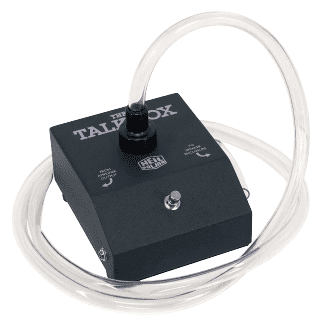
Once people got a taste of these cosmic sounds, the talk box transitioned from oddity to an essential tool overnight. Subsequently, talk boxes started showing up on iconic recordings across genres from funk to metal to hip hop.
Over 80 years since Alvino Rey’s humble basement tinkering, the talk box remains one of the most coveted effects for its unmatched ability to generate sounds not possible with any other technology.
Breaking Down the Inner Workings of Talk Box Circuitry
The key to unravelling the mysteries of the talk box is to understand how its components work together to transform sound:
- Input Jack – The talk box first needs an incoming signal to process. This is provided by connecting the talk box input to an external amplifier or preamp source via a standard 1/4” jack. This feeds the raw instrument tone into the unit.
- Internal Speaker – Inside the talk box, a built-in speaker amplifies the input signal from the source instrument. This is typically a 3 to 6-inch speaker driver, often the same kind used in small guitar amp combos. It needs to handle about 5 to 10 watts of power.
- Plastic Tubing – Clear vinyl plastic tubing extends from the internal speaker up to the general area of the user’s mouth. This tunnels and directs the sound for the user to articulate vowels, consonants, and syllables. For optimal performance, the tubing should have wire reinforcement through the length to maintain its cylindrical shape and keep the walls from vibrating.
- Mouthpiece – The end of the tubing connects to a mouthpiece allowing the performer to vocalize sounds by shaping them with their mouth cavity and articulators. High-quality talk boxes will have custom moulded mouthpieces often made from materials like silicone for maximum comfort during extended use. Having a hands-free mouthpiece improves mobility.
- External Microphone – A dynamic cardioid microphone is externally mounted very near the mouthpiece on a boom arm to capture the sound being vocalized by the user. Condenser microphones tend to pick up more noise during talk box use. The proximity effect from close positioning accentuates desired low frequencies.
- Circuit Board – The conditioned microphone signal is then routed through an effects circuit board inside the talk box. This applies crucial sound-shaping including equalization, compression, distortion, feedback rejection, and noise gates tailored to optimize the talk box tone.
- Output Jack – The final shaped vocal effect tone exits the talk box via a 1/4” output jack to be sent to an external amplifier or PA system for gaining volume to sit in the mix. Higher-end talk box models include effects loop jacks for further processing.
Understanding this flow of the signal from raw source to processed vocalization is the key to tweaking and improving your particular talk box sounds. So now let’s explore techniques for extracting the very best tone from talk box gear.
Expert Sound Optimization Techniques for Dialing in the Ultimate Talk Box Tone
With careful tweaking and refinement of both playing technique and talk box settings, you can coax an incredibly wide palette of tones from even very basic talk box circuitry:
- Swap the plastic tubes – Try tubing of different materials like smooth vinyl, ribbed vinyl, or rubber. Also, experiment with tubes of varying lengths and diameters to profoundly change the harmonics and responsiveness.
- Play with different mics – While dynamic mics tend to capture clearer talk box articulation overall, you can try small diaphragm condensers for a crisp edge. Ribbon mics can impart a pleasing warmth.
- Dial in an optimal noise gate – Use a noise gate pedal or your amp/mixer’s noise gate to remove any unwanted residual noise or hum when you are not actively articulating sounds through the talk box. Careful threshold and decay shaping is key.
- Shape your core tone with EQ – Cut muddiness and problematic low-mid resonances while carefully boosting brightness and midrange bite to help craft your ideal synthetic vocal tone. This can be done at the preamp, effects loop, pedal, and console channel stages.
- Experiment with different drive and distortion colours – Pushing the talk box signal with tube preamp overdrive or distortion pedals before it enters the talk box can lead to more dramatic and aggressive vocal effects. Play with distortion tone-shaping controls like gain, tone, and output volume.
- Alter your actual mouth position – Subtly changing the position and shape of your tongue, lips, jaw, and soft palate will radically change the sound of the vowels you can produce. Approach this exploration systematically to learn new sounds.
- Articulate consonants and endings with precision – Carefully and slowly enunciating consonants, syllables, and the ends of phrases will ensure maximum clarity and intelligibility of talk box words and lines. Mimic speaking clearly and robustly like you would through a handheld megaphone.
- Develop rhythmic interplay between music and mouth – Syncopating your mouth movements precisely in time with your core instrumental groove is absolutely crucial for nailing those pumping, energetic talk box riff parts. Internalize rhythms deeply.
With extended exploration and dialling in of the talk box signal chain, you can learn to radically alter the core tone of your talk box vocals from warm and throaty to piercing and icy. Now let’s look at mastering real-time mouth articulation techniques for shaping the most advanced effects.
Talk Box Articulation Mastery: Taking Your Skills to the Pinnacle of Sound-Sculpting Ability
Learning to precisely articulate individual sounds through the talk box is the main hurdle to overcome on the path to achieving the kinds of otherworldly vocal effects you hear on iconic recordings. Follow these pro techniques to take your talk box skills to the cutting-edge professional level:
- Master sustaining long vowels first – Hold extended “Oooo” and “Aaaa” notes while smoothly transitioning between them. This acclimates your mouth to comfortably project within the confined tube. Make the volume and tone as even as possible throughout the duration.
- Incrementally build up complexity – Gradually build up articulation ability starting from isolated single syllables, moving to simple repetitive words, and eventually getting to short phrases of 2-4 words. Stay focused on perfectly enunciating every sound.
- Practice rapid-fire percussive syllables – Try syncopating faster tongue-forward consonant sounds like “dee”, “tah”, “kee” to play punchy percussive riffs. This improves articulation velocity and clarity.
- Apply beatboxing techniques – Beatboxing effects like vocal pops, lip oscillations, clicks, and scratches can generate radical glitchy robotic textures when vocalized through a talk box.
- Emulate amplified speech patterns – Practice talking clearly, slowly, and deliberately through the tube as if you are making announcements through a handheld megaphone. Use this as a template for talk box melodic lines and phrases.
- Improvise random melodic riffs – Noodle on your instrument while freely vocalizing any melodies that come to mind through the talk box. Don’t self-judge. This improves pitch control and the brain-to-mouth connection.
- Relax mouth muscles as much as possible – While articulating, keep your mouth muscles loose and gently explore the widest possible range of mouth positions and vowel sounds. Avoid tension. Discover new resonances.
- Contrast techniques for interest – Alternate sections of rhythmic riffing and deadpan robotic tones with more inflected melodic lines and emotional vocal qualities. Vary the articulation between sections.
With extensive practice and playing time, you’ll be shocked at the wide range of alien sounds that you can conjure seemingly at will through the talk box. Now let’s look at how the masters have used it.
Advanced Tips and Tricks for Experienced Users
The talk box is a classic effect that has been used by guitarists and vocalists for decades to create a signature robotic vocal sound. While a basic talk box setup is relatively straightforward, some advanced techniques can take your talk box skills to the next level. In this article, we’ll explore some pro tips and tricks for experienced talk box users who want to get more creative with this iconic effect.
Choose the Right Talk Box
Not all talk boxes are created equal when it comes to sound quality and features. Look for a sturdy, road-worthy model from trusted brands like Dunlop, Rocktron, or Electro-Harmonix. Make sure it has a built-in adjustable frequency control so you can sculpt the tone and dial in the perfect vowel sounds. High-end models like the Dunlop HT-1 Signature Talk Box have useful extras like mute switches and line output jacks for routing to your PA system.
Master Your Amp Settings
Your amp needs to be optimized for talk box use. Turn up the gain and treble to cut through the mix. Set the mids scooped and pull back on the bass. You want an aggressive yet focused tone to articulate syllables clearly through the talk box. A tube amp with sufficient headroom works best. Make sure to position your amp properly to take advantage of the talk box horn. Angle it up towards your mouth for maximum projection.
Use a Compressor
A compressor pedal is crucial for evening out your volume and allowing notes to sustain through the talk box. Dial in medium sustain and enough compression to smooth out any wavering in your volume as you articulate words. This lets you riff smoothly and maintain consistent vowel and consonant sounds.
Experiment with Different Mics
While a standard dynamic mic works fine, it pays to experiment with different mics and placements. Try a condenser mic or a bullet mic positioned very close to your mouth. Off-axis mic positioning can alter the tonality and attack the envelope in interesting ways. Use a pop filter for explosive consonants. There are also talk box-specific mics like the Dunlop HT1 that optimize talk box tone and articulation.
Practice Proper Mouth Shaping
How you shape your mouth is just as important as what you play through the talk box. Exaggerate your mouth movements, over-enunciate consonants, and hold vowel sounds. Use your tongue, lips, and jaw to crisply articulate rhythms and melodic patterns. It takes practice to synchronize your mouth with what you’re playing to achieve speech-like effects.
Incorporate Vocal Sounds
Don’t just stick to guitar tones through the talk box – incorporate your actual voice too. Alternate sung tones and vowels with playing melodies through the talk box for a more human, vocalized effect. Looping your riffs while you sing over them through the talk box opens up creative possibilities.
Explore Effects Combos
Chaining the talk box together with other effects pedals can produce some very unique sounds. Try combining with a flanger or phaser for sweeping, modulated speech effects. An octave pedal fattens up talk box tones. Delay and reverb expand your spatial presence and “voice in a can” resonance. Get creative with stacking effects before and after your talk box.
By following these pro tips, experienced talk box players can take their skills to new levels and get the most out of this iconic guitar and vocal effect. From dialing in the perfect tone to sharpening your articulation techniques, applying these tricks will help you speak fluent talk box.
A Sample Of Talk Box Models Available Online

Dunlop HT1 Talk Box – A standard and relatively affordable analog talk box. Has basic controls and produces classic talk box sounds.
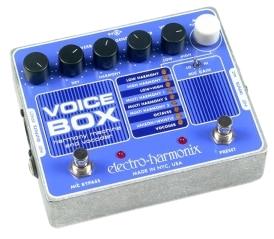
Electro-Harmonix Voice Box – A compact analog talk box with a built-in amp/speaker. Convenient all-in-one unit.
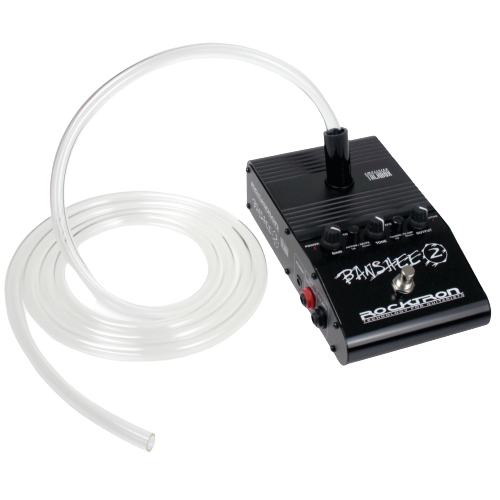
Rocktron Banshee Talk Box – A more advanced analog talk box with added features like an effects loop and mic input. Provides more tone-shaping options.
These cover just some of the major talk box models and price ranges. I’d recommend watching demos of each to hear the differences in sound.
Legendary Talk Box Moments That Made Musical History
Once you’ve elevated your talk box skills, it’s highly educational to closely analyze the iconic musical moments that utilized the effect to create career-defining sounds:
- Peter Frampton’s epic solo on “Show Me the Way” – This full two-minute mid-song solo is a masterclass in fluidly blending melodic phrasing, drastic dynamic shifts, and rhythmic riffing with perfect talk box articulation.
- Joe Walsh’s punchy main riff line in “Rocky Mountain Way” – Walsh’s gritty talk box tone mixed with his rhythmic vocalization creates an instantly memorable syncopated hook that drives the entire tune.
- Roger Troutman’s verse lines in Tupac’s “California Love” – Troutman demonstrates incredible technique accenting his soulful vocal inflections with percussive rhythmic vibrato for seamless integration with hip hop flow.
- Jeff Beck’s wailing work on Stevie Wonder’s “Thelonius” – Beck uses the talk box to conjure weeping, sorrowful effects that blend and spar beautifully with the harmonica tones just like two voices trading licks.
- The Scorpions’ Klaus Meine in “The Zoo” – Meine harnesses the talk box to transform his voice into something totally inhuman and sinister befitting the dark lyrics.
- Bon Jovi’s talk box melodic accents in “Livin on a Prayer” – The talk box stretches Jon Bon Jovi’s vocal range allowing higher register melodic runs not possible otherwise for huge hook power.
These examples cement the talk box’s legacy as a key effect behind some of the most memorable recordings in modern music. Make it your mission to carry on that legacy by sculpting your own forward-thinking innovation!
Frequently Asked Questions
Do you need special skills to use a talk box?
Yes, using a talk box takes practice and skill. The musician has to coordinate their mouth movements and articulations with their playing to shape the sounds into desired effects. It’s essentially like talking through your instrument.
Can you buy an affordable talk box for beginners?
Yes, companies like Dunlop and Rocktron make reasonably priced talk box effect pedals in the £115-£220 range for beginners to experiment with basic talk box sounds.
What maintenance does a talk box require?
Keeping the plastic tubing clean and sanitary is important. Tubes should be replaced periodically or cleaned regularly to avoid the buildup of bacteria and mold from moisture.
Are there any health risks associated with talk boxes?
Extended use can cause jaw soreness, lip fatigue, and excessive mouth dryness. Proper hydration and limiting use are advised. There may also be hearing risks from high sound pressure levels.
Conclusion
There is absolutely no need to be intimidated by the talk box’s unconventional workings and unique technique requirements. With extensive knowledge of its components, precision attention to set up details, regular practice sessions, and creative vision; the possibilities are truly endless for the tones you can produce.
From alien glitch effects to tongue-twisting rhythmic riffing to soul-stirring melodies, the talk box can elevate your music to new dimensions. Learn it thoroughly and integrate it thoughtfully into your songs, and you will be ready to take your sound far beyond the limits of this planet! The only barrier is your own imagination.
